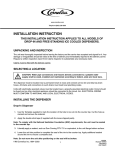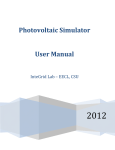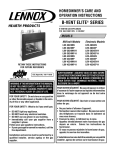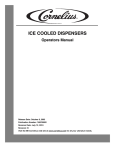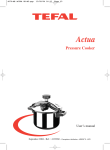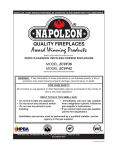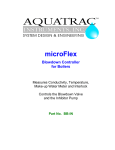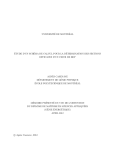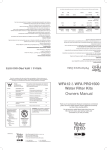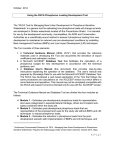Download Flowmatic FMR04-ZW User's Manual
Transcript
INSTALLATION, OPERATION AND MAINTENANCE MANUAL Warning Please read carefully before proceeding with installation. Your failure to follow a attached instructions or operating parameters may lead to the product's failure and possible damage to property. ******************************************************************************************* Save manual for future reference. Model FMRO4-ZW ZER O WASTE R EVER SE OSMOSIS SYSTEM Thank you for your purchase of a Flowmatic Reverse Osmosis system. With proper installation and maintenance, this system will provide you with high quality water for years to come. All of Flowmatic water enhancement products are rigorously tested by independent laboratories for safety and reliability. If you have any questions or concerns, please contact our customer service department at 1-800-461-4406 TABLE OF CONTENTS Operational Parameters ............................................................ 3 ZRO-4 System .......................................................................... 3 Tools recommended for Installation ........................................... 3 Installation of faucet .................................................................. 4 Installation of hot and cold water line fittings ................................ 5 Mounting the RO module .......................................................... 6 Connecting the tube to faucet .................................................... 6 Connecting the tubes to the hot & cold water supply valves. 6 Installation of storage tank ......................................................... 7 Connecting the tank .................................................................. 7 Start up instructions .................................................................. 8 Semi-annual Maintenance ......................................................... 8 Annual Maintenance ................................................................. 9 Membrane Maintenance ........................................................... 10 Trouble Shooting ...................................................................... 11 Check air pressure in the tank .................................................... 11 Adjust faucet ............................................................................. 12 Service Record ......................................................................... 13 Warranty .................................................................................. 14 Drawing and Parts list ................................................................ 15 Other products .......................................................................... 16 2 Operational Parameters Do not use with water that is microbiologically unsafe or of unknown quality, without adequate disinfection before or after the system. Operating Temperatures: Maximum 100°F (37.8°C) Minimum 40°F ( 4.4°C) Operating Pressure: Maximum 100 psi (7.43 g/cm2) Minimum pH Parameters: Maximum Iron: Maximum 0.2 ppm TDS (Total Dissolved Solids): Turbidity: < 1000 ppm 11 Minimum 40 psi (2.80 kg/cm2) 3 <5NTU Hardness: Recommended hardness not to exceed 7 grains per gallon, or 120ppm. System will operate with hardness over 7 grains but the membrane life may be shortened. Addition of a water softener may lengthen the membrane life. Note: RO unit must be installed a mimimun of 25 feet from hot water heater. FMRO4-ZW System System includes: RO module, 24 volt Pump, 3 gal Storage tank, Long reach faucet, Manual, Warranty Card, Parts Bags, (2 Water line fitting valves, 2 Washers,Transformer, 2 Mounting screws, 1 Teflon tape roll, 2 Brass inserts, 2 Plastic sleeves, 1 Ball v al v e,one1/ 4”Connec t or ) Tools recommended for installation 7/ 16”Drill bit for faucet Channel lock piers Phillips Screw Driver 1/2" - 5/8" Open End Wrench Adjustable Wrench Sharp knife Electric Drill 3 Installation of Faucet Caution: Porcelain sink surface material is extremely hard and may crack or chip. Use extreme caution when drilling. Watts accepts no responsibility for damage resulting from the installation of the faucet. Black Locating Washer (used where a 1/2" hole is available, reverse when mounting on stainless steel or when using drilled hole) Brass Insert (sleeve) 1 /4" Tub Plastic Sleeve 1 /4" Compression Nut Step 1 Step 2 D etermine desired location to drill a hole for the faucet on your sink. Usi ngav ar i abl espeeddr i l lont hesl owestspeed,dr i l la7/ 16”hol ef ort hefaucet.Use water to keep the drill bit cool while drilling. (If the drill bit gets hot it may cause the porcelain to crack or chip). Step 3 Place the escutcheon chrome plate and the black rubber washer on the faucet shank. (Parts found in faucet parts bag). Step 4 Insert the faucet shank through the hole in sink and let it rest on the sink top. Step 5 From the underside of the sink slide on the locating washer, lock washer and brass nut onto the shank. Check orientation of faucet then tighten brass nut securely. 4 Installation of hot and cold water supply line valves For3/ 8”pl umbi ng For1/ 2”pl umbi ng Hand tighten brass nuts then apply 1/4 turn with a wrench. To RO System 1/4" Compression Nut 1/4" Compression Nut Plastic Sleeve Brass Plastic Sleeve Insert Brass Insert 3/8"M X 1/2"F Adapter Angle Stop Valve (not included) Rubber 1/2"M X 3/8"F X 1/4"Comp. with needle valve Angle Stop Valve (not included) Washer RO Tubes will be connected on page 6. Step 6 Turn off the hot and cold water supply to the faucet by turning the angle stop valves off. Step 7 Remove water supply line at faucet to the angle stop valves. Step 8 Attach the water supply line valves as illustrated in the drawings above. Step 9 Re -attach the water supply line to the fittings attached to the angle stop valves. 5 Mounting the RO module Step 10 Determine the best location for the RO Module to be mounted and allow for future system maintenance. Use a Phillips screwdriver and secure the screws 5 3/ 4”apar tand16”f r om t hebot t om oft hec abi net . Note: There will be (2) Blue, (1) Green and (1) Black coming from the module. Do not cut these tubes at this time. Connecting to the faucet Step 11 Connect blue tube from in-line filter over to the faucet shank. Place the brass nut onto the tube, followed by the plastic sleeve (tapered end pointing to the end of tube) and then place the brass insert into the end of the tube. Step 12 Insert the blue tube into the end of the faucet shank and use a wrench to tighten the brass nut securely. Connect the hot and cold water supply line valves St ep13I ns er tt heGr eent ubei nt ot heCol dwat erneedl ev al v ef i t t i ng1/ 4” tube compression fitting until it stops. Slide the Nut and Plastic Sleeve down to where you can thread them onto the male pipe t hr eads .Us ea1/ 2”wr enc ht os ec ur el yt i ght en. Step 14 Insert the Black tube into the Hot water needle valve fitting 1/ 4”t ubec ompr es s i onf i t t i ngunt i l i ts t ops .Sl i det heNutand the Plastic Sleeve down to where you can thread them onto the mal epi pet hr eads .Us ea1/ 2”wr enc ht os ec ur el yt i ght en. 6 Installation of Storage Tank Step 15 Step 16 Apply Teflon tape in a clockwise direction around the male pipe threads on the tank. Thread the ball valve (supplied in the parts bag) onto the stainless steel connector on the tank. Note: Do not over tighten plastics connections. Step 17 Thr ead1/ 4”pl as t i cc onnec t orf i t t i ng( s uppl i edi nt he parts bag) into the ball valve attached to the tank. Connecting the Tank Step 18 Postion the tank in the desired location. Stand it upr i ghtorus i ngbl ac kpl as t i cs t andl ayi toni t ’ ss i de. Connect remaining blue tube from he RO module over to the tank ball valve connector. Step 19 Push blue tube into the connector on the end of ball valve until it stops. Use a wrench to securely tighten the nut on the connector. 7 Start up Instructions Warning: To prevent the possibility of electrical shock, clean up any water on cabinet floor and dry all water from outside of RO unit. Step 1 Turn on the incoming hot and cold water angle stop valves. Turn on the water line needle valves by turning counter clockwise. Check the system for leaks and tighten fittings as necessary. Note: Check daily over the next week to ensure no leaks are present. Step 2 Plug the (24 volt) transformer power cord connector into the RO system wire harness connector (labeled transformer.) Step 3 Plug the transformer into the electrical outlet under the sink. Step 4 Ensure ball valve on tank is open. Step 5 Open the RO faucet and leave it open until water begins to drip. Then close the faucet. The tank will take 2 to 4 hours to fill completely. Note: Water may be cloudy or milky due to air in the system. This conditions will resolve its self after a couple of tanks of water. After a final filter change you will see gray water until the carbon particles have flushed from the filter. Step 6 After the tank has filled once, open the RO faucet and drain the tank. Step 7 Close RO faucet and allow the tank to fill, (2-4 hours). System is now ready to use. Note: This system can be hooked up to an ice maker. Place a tee after the final filter and before the faucet. It is recommended to install a ball valve on the ice maker line. This enables you to shut off the water supply to ice maker while the tank is filled and flushed to remove the carbon particles from the final filter. Each time the tank becomes empty you will need to close the water supply to the ice maker until the tank refills. Semi-annual maintenance Step 1 Turn off the water supply line needle valves. Step 2 Close the ball valve on the tank. Step 3 Step 4 Step 5 Step 6 Open the RO faucet to allow the system to depressurize for 5 - 10 minutes before attempting to remove Housings. Unplug transformer from electrical outlet. Carefully remove the filter housings and pour water out of the housings. Dispose of the used filters. Wash housings with mild soap and rinse thoroughly with water. 8 Semi-annual maintenance continued Step 7 Inspect O-rings for wear and replace them if needed (order part no. WP113029 from Watts.) Lubricate O-rings with a water soluble lubricant such as KY Jelly®, (petroleum based lubricants such as Vaseline® must not be used.) Be sure to properly seat the O-ring in the housing before threading the housings onto the lid assembly. Note: Keeping the RO module in an upright position while reattaching the housings will help ensure the o-ring stays properly seated and reduces the possiblity of leaks. Step 8 The sediment filter has a cloth like appearance. It must be placed in the 1 st housing on the left where the water inlet connects. Step 9 The carbon bock filter has a mesh covering and has a gasket on each end. Replace the filter in the 2nd housing with the carbon block filter. Step 10 Visually inspect oring to be sure they are properly seated before threading the housing onto the lid assembly and hand tighten securely. Annual Maintenance Step 1. Step 2 Perform Semi-annual Preventive Maintenance Steps on page 8. Note: For the annual maintenance drain the tank. Replace the final filter by removing the white nuts from both ends of the filter. Remove the connectors from both ends (keep and reuse). Discard the old final filter and replace with new filter reusing the connectors. Note: Flow arrow on final filter must be pointing in the direction of water flow to the faucet. Step 3 The tank shut off switch has quick-disconnect connectors. Remove the blue tube from the tank side of the tank shut-off switch. Depress the gray ring with the tip of your finger and pull the tube straight out . Step 4 Use a clean eye dropper to insert ½ teaspoon of 3% hydrogen peroxide or common house hold bleach into the blue tube. (This will flow into the tank once water is turned back on to unit.) Step 5 To reconnect insert tube into the connector and push firmly. Step 6 Follow Start Up procedure on page 8. 9 Membrane Maintenance Membrane filters have a life expectancy of 2 to 5 years, depending on the incoming water conditions and the amount of use of the RO system. If at any time you notice a reduction in water production or a change in the taste of the RO water, it could be time to replace the membrane. Step 1 To change the membrane, use a 5/8" wrench to remove the nut from the cap side of the membrane housing (the end with only one elbow). Remove the cap from the white horizontal membrane housing. Note: To assist with the removal of cap a double sided wrench canbe purchased from Watts Premier. Step 2 Using a pair of pliers, grip and pull firmly on the membrane filter to remove it from the housing and discard the membrane. Step 3 Unwrap new membrane filter and lubricate the o-rings with water soluble lubrication such as KY Jelly® . Insert the end with the two black O-rings into the membrane housing. Step 4 Once membrane filter has been inserted into the housing you must take your thumbs and give a firm push to properly seat the membrane. Replace membrane housing cap and tighten. Note: To be properly seated the tip of the membrane filter must be below the housing edge. Step 5 Screw the membrane filter housing cap back on securely. Step 6 Connect the green tube back to the membrane cap fitting. Step 7 You must change the flow restrictor each time you change the Membrane filter. Replace the existing flow restrictor with the new one by removing the White compression nuts. Make sure the arrow is pointing toward the check valves and hot water line fitting. Step 8 Follow Start Up procedures on page 8. Trouble shooting Problem Cause Solution Low/slow production Excessive air pressure in tank Relieve pressure at Schrader valve on tank (set to 7 psi with the tank empty) Pump not operating Fouled membrane Plugged pre-filters Crimped tubing Angle stop or water line valve not fully opened Milky colored water Air in the system Faucet Dripping Pump short cycles Needs adjustment Ball valve on tank closed Blue tube blocked between the tank and RO system Faulty pressure switch Damaged/Dry O-ring Bowl leaks at the top after changing the filters Pump constantly running Electrical fault Faucet left on Plugged pre-filters Wiring connection broken (plug 110 AC wall plug back in at wall and/or reconnect the 24 VAC wire harness connectors) Replace pump if needed Replace membrane Replace filters Check tubes to make sure they are not kinked Ensure valves are opened by turning valve handle counter clockwise until it stops Air in the system is a normal occurrence with initial start up of the RO system. This milky look will disappear during normal use within 1-2 weeks. If condition reoccurs after filter changes, drain tank 1 to 2 times. see page 12 Open the ball valve on the top of the tank Remove kinked/damaged section and replace if necessary Call for technical support Lubricate with water soluble lubricant or replace O-ring as necessary (Do not use Vaseline or other petroleum based lubricants) Call for technical support Close faucet and let tank fill for 2 to 3 hours Replace filters Checking air pressure in tank Note: Check air pressure when tank is empty. Step 1 Open faucet and drain the tank. Step 2 Using a digital air gauge check the air pressure in the tank. There should always be between 5-7 psi. Step 3 If you have more than 7 psi release air and recheck. If you have less than 5 psi, add air. Air can be added with a bicycle pump. 11 Adjust Faucet If the faucet has developed a drip it can be corrected by following the steps outlined below. Step 1 Remove faucet Spout first. Position both thumbs on the back edge of the lever and push forward. Step 2 Lever will slide forward and completely off of the faucet base. Step 3 Small brass tee can be turned 1/2 turn, counterclockwise, to adjust the tension on the black lever. This adjustment may be necessary to stop slow drips from tip of faucet. You may need to repeat the process until the faucet does not drip. Brass tee must always end up facing across body of faucet in order to slide black lever on. 12 SERVICE RECORD DATE OF PURCHASE / / DATE OF INSTALL / / Date of Maintenance (6 mos.) 2nd stage Carbon Block (6 mos.) 1st stage Sediment INSTALLED BY NAME: (1 yr.) Final Filter Carbon NOTES: 13 (2-5 yrs.) TFM Memb. SERIAL NO. # OTHER Limited Warranty What your Warranty Covers: Limited 3 year warrranty on the Reverse Osmosis module, tank and faucet if defective. 1 year warranty on the electrical components, pump, pressure switch, solenoid valve, and transformer if defective. No warranty on replaceable filters and membranes. Return unit after obtaining a return authorization (see below), less tank, within 3 year of original retail purchase, FLOWMATIC SYSTEMS will repair or, at FLOWMATIC‘ S option, replace the system at no charge. How to obtain Warranty Service: For warranty service, call 1-800-461-4406 for a return authorization number. Then, ship your Reverse Osmosis unit (less tank) to our factory, freight and insurance prepaid, with proof of date of original purchase. Please include a note stating the problem. Flowmatic will repair it, or replace it, and ship it back to you prepaid. What this warranty does not cover: This warranty does not cover defects resulting from improper installation, (contrary to FLOWMATIC SYSTEM's printed instructions), from abuse, misuse, misapplication, improper maintenance, neglect, alteration, accidents, casualties, fire, flood, freezing, environmental factors, or other such acts of God. This warranty will be void if defects occur due to failure to observe the following conditions: 1. The Reverse Osmosis System must be hooked up to a potable municipal or well cold water supply. 2. The hardness of the water should not exceed 7 grains per gallon, or 120 ppm. 3. Maximum incoming iron must be less than 0.2 ppm. 4. The pH of the water must not be lower than 3 or higher than 11. 5. The incoming water pressure must be between 40 and 100 pounds per square inch. 6. Incoming water to the RO cannot exceed 105 degrees F (40 degrees C.) 7. Incoming TDS/Total Dissolved Solids not to exceed 1800 ppm. 8. Do not use with water that is micro-biologically unsafe or of unknown quality without adequate disinfection before or after the system. This warranty does not cover any equipment that is relocated from the site of its original installation. This warranty does not cover any equipment that is installed or used outside the United States of America and Canada. LIMITATIONS AND EXCLUSIONS: FLOWMATIC SYSTEMS WILL NOT BE RESPONSIBLE FOR ANY IMPLIED WARRANTIES, INCLUDING THOSE OF MERCHANTIBILITY AND FITNESS FOR A PARTICULAR PURPOSE. FLOWMATIC WILL NOT BE RESPONSIBLE FOR ANY INCIDENTAL OR CONSEQUENTIAL DAMAGES, INCLUDING TRAVEL EXPENSE, TELEPHONE CHARGES, LOSS OF REVENUE, LOSS OF TIME, INCONVENIENCE, LOSS OF USE OF THE EQUIPMENT, AND DAMAGE CAUSED BY THIS EQUIPMENT AND ITS FAILURE TO FUNCTION PROPERLY. THIS WARRANTY SETS FORTH ALL OF FLOWMATIC'S RESPONSIBILITIES REGARDING THIS EQUIPMENT. OTHER CONDITIONS: If Flowmatic chooses to replace the equipment, Flowmatic Systems may replace it with reconditioned equipment. Parts used in repairing or replacing the equipment will be warranted for 90 days from the date the equipment is returned to you or for the remainder of the original warranty period, whichever is longer. This warranty is not assignable or transferable. YOUR RIGHTS UNDER STATE LAW: Some states do not allow limitations on how long an implied warranty lasts, and some states do not allow the exclusion or limitation of incidental or consequential damages, so the above limitations or exclusions may not apply. This warranty gives you specific legal rights, and you may have other legal rights which vary from state to state. 15 21
















